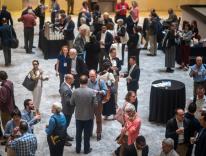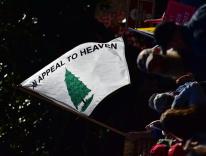In 1896 the Lumière brothers, French pioneers of motion pictures, traveled to Jerusalem, then part of the Ottoman Empire, to film scenes of daily life. In the soundtrack to the remarkable footage (added later, as it was not technically possible to record sound at the time), we hear the clop of horses on cobblestones, the Muslim call to prayer, and the collision of church bells ringing out across the city. As various pedestrians flicker in and out of the grainy frames, a voiceover narrator identifies them one by one: “A veiled Sunni woman, one of the majority. An Orthodox Jew...an Armenian pope,” all of whom go about their business in the shadow of the “holy places of the three religions”—Judaism, Christianity, and Islam—“scattered across a few hundred square meters.” The camera pauses at the Western (or Wailing) Wall—a remnant of the Temple Mount compound, Judaism’s holiest site—where we see a solitary Jew praying. “He is wearing a Turkish tarboush (fez),” the narrator intones, “and although he prays in Hebrew, his everyday language is Arabic.”
Just as this pious, Arabic-speaking (but distinctively Ottoman hat–wearing) Jew defies convenient categorization, so too does the city he inhabits. Journalist Matthew Teller’s myth-busting exploration of the ancient capital—revered by medieval cartographers as “the navel of the earth”—shines a welcome light on the staggering diversity of Jerusalem today. While the toponym is debatable (the ancient Greeks made similar claims about Delphi), Teller reserves his harshest criticism for the modern colonial mapmakers who superficially segmented Jerusalem into quarters—Christian, Muslim, Jewish and Armenian—a division which “underpins the common assumption that the present-day conflict in Jerusalem comes down to age-old hatred between religions...a falsehood worth debunking.”
Prior to the nineteenth century, if there were anything approaching “quarters” in Jerusalem (a name possibly derived from the location’s association with the ancient Canaanite god Shalim) it would be its harat, or neighborhoods, of which there were as many as thirty-nine at one point, nestled within the confines of the Old City’s Ottoman-era defensive stone walls, an area of some 0.35 square miles. Some harat (singular, haret) took their names from the respective faiths of their primary residents, such as Haret al-Yuhud (Jews) or Haret an-Nasara, a general term for Christians, linguistically derived from the town of Jesus’ childhood, Nazareth. Yet many others reflected the occupations of its residents or adjacent commercial activity. Cotton merchants dwelled in Haret al-Qattanin “named after a long-established covered market” while Haret Khan al-Zeit, from the Arabic for olive, zaytun, was the location of the city’s major oil bazaar. Still others took their names from tribal connections, such as Haret as-Sa’adiyya, “named after the Bani Sa’d tribe, who had long ago settled in the lanes between Herod’s Gate and Damascus Gate,” or Haret al-Magharba, home to Muslims who traced their ancestry to the Maghreb (Muslim North Africa). Distinctive, yet cohesive, these neighborhoods were the unifying warp and woof of Jerusalem’s rich and colorful, ethno-religious tapestry. “All,” as Teller states, “had emerged organically.” Then, “the British arrived.”
During the mid- to late-nineteenth century, as Ottoman power began to wane, successive waves of British diplomats, armed forces, engineers, mapmakers, and missionaries descended upon the Holy Land, more or less claiming it as their own in the interest (well, their interest anyway) of maintaining stable access to the crown jewel of their colonial possessions, India. The cartographers and clergy figure prominently in Teller’s story. British Christian missionaries “had long had their eye on the unevangelized peoples” of the Middle East, an obsession that dated back to the Crusades and was fueled by the “urge to restore Christian rule over Jerusalem.” Meanwhile, British mapmakers, gazing cross-eyed at the city’s overlapping network of harat, groped “for a handle on a place they barely understood, intent on asserting their own legitimacy among a hostile population, seeing what they wanted to see.” To bring it all into Western, imperial focus, they arbitrarily drew boundary lines around the aforementioned religious quarters which had never actually existed: literally a classic colonial exercise in “divide and conquer.”
While a bevy of British military engineers, civil servants, and missionaries took turns sketching imaginary lines on maps of the city, Teller ascribes the final, fallacious quartering of Jerusalem to the Reverend George Williams, an Eton-educated Cambridge University graduate. Despite his elite academic credentials and two years (1841 to 1843) in the city as chaplain to the Anglican bishop, Williams (in Teller’s estimation) neither understood Arabic nor had “a clue what he was looking at” when consulting earlier maps of the city. Nonetheless, Williams’s 1849 book, The Holy City, features the now-familiar four quarters which no resident at the time (nor any current resident) would recognize as actual geographic demarcations.
“We never use ‘Muslim Quarter’ in Arabic,” Mustafa Abu Sway, professor of Islamic Studies at Al Quds University informs Teller. “I am more than sixty years old, and I have never used that term except in an academic setting and media interviews.” Local Muslims, according to Sway, don’t answer in Quarters when asked where they are going, but in landmarks: Al-Aqsa, the market, Al-Wad street, etc. “The notion of ‘Muslim Quarter’ is absent from our daily language,” Sway summarizes.
And yet, nearly every map, every guidebook, every reference work—including, as Sway attests, scholarly studies—of Jerusalem’s Old City published in the non-Islamic world, and even within it, divides the location into four quarters. While Teller acknowledges that a long line of subsequent colonial administrators perpetuated this “cartographic fantasy,” the gist of his thesis is “shame on you, Rev. Williams.”
With this historical background firmly in place, Teller proceeds to take the reader on a guided tour of the city he knows and obviously loves by interviewing and interacting with residents like Sway and others who similarly have little use for Williams’s map coordinates. We meet Amoun Sleem, a woman in her late forties and a member of the city’s 1,500-year-old Gypsy (her designation, not Teller’s) aka Dom community of a thousand or more, half of whom live in the northeast corner of the Old City, near the Lion’s Gate. (The Old City walls have seven surviving gates, dating to the sixteenth century. They are variously named for directional orientation, e.g. the Damascus Gate, or individuals, like Herod’s Gate, or architectural features, such as the carved lions above the Lion’s Gate. This being the Old City of Jerusalem, however, even these names are fluid, and locals also refer to them by their ethnic associations or by corruptions of older Hebrew or Arabic names.)
Growing up, Sleem heard the Dom language (Domari) spoken in her haret. Now she is an advocate for Jerusalem’s Dom community (vocational training and literacy classes for women, for instance) and for its children to be educated in Domari culture, which is fading from memory. Like many Dom worldwide and throughout history, her people have been subject to harsh discrimination. Arabic-speaking and mostly Muslim, Jerusalem’s Dom community has been shunned by Palestinian and Israeli authorities alike, Sleem reports. Too many people, she says, “stick to old stereotypes about Gypsies”—a status she strives to amend.
In the shadow of the Haram al-Sharif—site of the Al-Aqsa mosque and the iconic, golden-roofed Dome of the Rock—sits the olive tree–shaded courtyard of the Afghaniya, a pilgrim’s lodge named for its “decades-long association with Jerusalem’s community of Afghans” who adhere to the Shadili order of Sufism, often defined as Islamic mysticism or asceticism. As far as Teller knows, the sacred sanctuary is the last place in the city to regularly hold dhikrs, spiritual ceremonies that blend theological discourse with rhythmic chanting, which Teller describes vividly.
Crossing from one artificial “Quarter” to another is an almost imperceptible exercise, but one of them does stand out in stark contrast to the others. The Jewish Quarter boasts architecture that is comparatively new, the area having been blasted to bits during two major conflicts, in 1948 (the year of Israeli independence) and in 1967 (the famous Six Day War). Teller introduces us to shopkeeper Esther Weiss, one of the first Jewish residents to move into the refurbished Quarter after 1967. She recounts its sights and sounds during those early years: “The mix of muezzins [Muslim prayer callers], church bells, listening to the Jewish study groups at the Wall on Shabbat afternoon. Everything coming to your home,” she recalls. “Eventually,” she says, with more of a shrug than regret, “many of the Arab families were compensated and moved out.”
If there is one disappointment in Teller’s otherwise entertaining and informative account, it is the book’s ambiguous title. How Teller arrived at nine quarters is never really explained, though perhaps it is hinted at. If there aren’t really four quarters in Jerusalem, there may as well be nine, or any other number for that matter. The answer is multilayered and complex. Jerusalem’s true quarters can’t be found on any map and remain elusive, until, like Teller, you seek them out and actually encounter the people who live there.
Nine Quarters of Jerusalem
A New Biography of the Old City
Matthew Teller
Other Press
$27.99 | 400 pp.
Please email comments to [email protected] and join the conversation on our Facebook page.
Previous Story
Continuing Not to Die
Next Story
Donald Trump's New York


